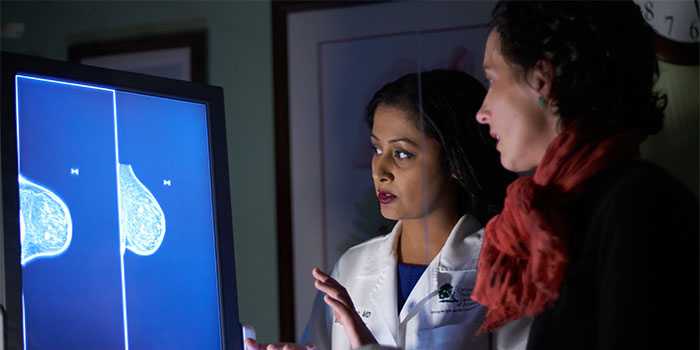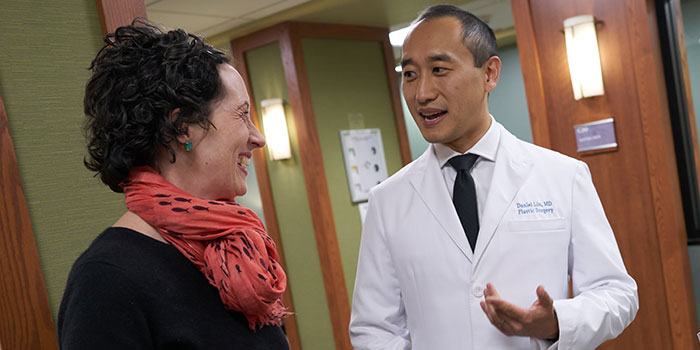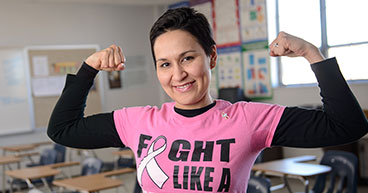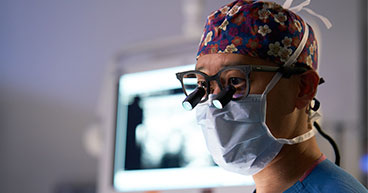
If your surgical oncologist has given you a choice between a lumpectomy and a mastectomy to remove a breast tumor, it’s typically because either surgery option will yield similar results in terms of your post-surgery prognosis. But which option is right for you is a nuanced question that may depend on your body type, the size of your breasts, your genetics, and your personal preferences and priorities.
As a Plastic & Reconstructive Surgeon at City of Hope, I regularly guide breast cancer patients through their breast reconstruction options after a lumpectomy or a mastectomy. One thing I’ve noticed is that many women haven’t been fully informed about the implications each surgery may have on their reconstruction options. They often don’t know what to expect in terms of recovery time, total number of surgeries and long-term cosmetic and functional results.
In this article, I’ll explain the potential differences between how a breast looks and feels after reconstruction following a lumpectomy or mastectomy, specifically:
- Differences between the two procedures (eligibility, treatment and survival rates)
- Factors to consider when evaluating both procedures
- Advantages and disadvantages of a lumpectomy
- Advantages and disadvantages of a mastectomy with reconstruction
- Questions to ask your doctor when deciding between a lumpectomy and mastectomy
- Reasons to get a second opinion on lumpectomy vs. mastectomy
If you’re weighing your surgical options after a breast cancer diagnosis and would like to consult a breast cancer expert about the advantages and disadvantages of each option, call us or chat online with a member of our team.
Lumpectomies vs. mastectomies: Differences in eligibility, treatment and survival rates
Before I get into the advantages and disadvantages of each type of breast cancer surgery, let's quickly define the two procedures and touch on what might make one option more appropriate than another for some women.
- Lumpectomy surgery (also called breast-conserving surgery) removes only the tumor and a margin of surrounding healthy tissue (and often one or more lymph nodes in the armpit).
- Mastectomy is a surgery to remove the entire breast (and often some lymph nodes in the armpit).
While any breast cancer patient can choose to undergo a mastectomy, only some are candidates for a lumpectomy. For early-stage breast cancer, if the tumor is small enough for a lumpectomy followed by radiation therapy, the two procedures typically have similar overall survival rates, although lumpectomy followed by radiation therapy has a slightly higher rate of recurrence. The risk of cancer metastasizing (or spreading to other parts of the body) is about the same with either surgery.
Recent advances in surgical techniques and pre-surgical cancer treatments (such as immunotherapy or targeted therapy) allow the breast surgeon to spare more healthy tissue, meaning more women are able to undergo the less invasive option of a lumpectomy.
This article isn’t the best venue for a thorough discussion of the decision-making factors that determine who’s a good fit for a lumpectomy, because those conversations largely rely on individual considerations unique to each patient. But we can share these two basic factors that tend to rule out a lumpectomy.
The patient can’t undergo radiation therapy.
If a woman is pregnant or has other medical conditions that may predispose her to experiencing severe side effects from radiation therapy, she wouldn’t be able to undergo a lumpectomy, because, to lower the risk of recurrence, a lumpectomy is almost always followed by radiation therapy to destroy remaining cancer cells.
The tumor is too large compared to the size of the breast.
The size of the patient’s breast often dictates whether the tumor is too large to remove via a lumpectomy. The decision may also depend on the location and type of tumor. Sometimes a small tumor is located in a part of the breast that makes it difficult to conserve much breast tissue, so a lumpectomy isn’t a viable option.
Factors to consider when evaluating both procedures
Determining whether you’re a candidate for breast reconstruction, and if so, which options you qualify for, is often a multi-step process that involves some back and forth between you, your breast surgeon, your plastic surgeon and the rest of your cancer care team.
The breast surgeon weighs in on whether a lumpectomy with radiation treatment would offer the same prognosis as a mastectomy. As a plastic surgeon, when I meet with a patient, I evaluate the potential long-term results in terms of how the breast may look and feel after each type of surgery.
It’s important for you to have healthy expectations about the cosmetic results of your breast cancer treatment. Poor results may impact your emotional well-being and your self-image long after your cancer treatment is over. Fortunately, with modern-day plastic surgery and oncoplastic surgery techniques, positive cosmetic outcomes are more common than not, whether you choose a lumpectomy or a mastectomy.
If you meet with a breast surgeon without consulting a plastic surgeon, you may not fully understand the cosmetic and functional implications of each choice, because breast surgeons are primarily concerned with removing cancer cells. A plastic surgeon can shed additional light on the cosmetic implications of the procedures based on the size of the tumor, your breast size, body type and long-term effects of radiation.
Regardless of our recommendation, some women who are eligible for a lumpectomy will still choose mastectomy or bilateral mastectomy (removing both breasts) because they have a genetic mutation that predisposes them to a second cancer in either the same or other breast. By removing one or both breasts, they may reduce their chance of developing a second breast cancer.
Advantages and disadvantages of a lumpectomy

Lumpectomy preserves sensation and function
Some patients prefer preserving part of the breast with a lumpectomy over removing the breast with a mastectomy because that allows them to retain some sensation and function in the original breast. It’s sometimes possible to preserve lactation after a lumpectomy—which is impossible with a mastectomy. Even if a tumor is large enough that the patient needs reconstruction after a lumpectomy, she may still be able to retain most of her feeling in the breast. For many women, preserving sensation in the breast is a major priority and one of the biggest reasons they choose a lumpectomy.
When a tumor is small enough to be removed without deforming the breast, surgical oncologists typically recommend a lumpectomy because it’s less invasive, doesn’t involve as much surgical intervention, tends to have a faster recovery and is generally less risky. And even though a lumpectomy typically involves radiation therapy, most women who undergo a lumpectomy without reconstruction tend to have good cosmetic results and don’t need to see a plastic surgeon.
If the tumor is large enough to require reconstruction, it’s sometimes possible to perform that operation during the same surgery as the lumpectomy. In that procedure, known as oncoplastic surgery, the breast surgeon removes the tumor, and then the plastic surgeon may perform a breast reduction or fill the cavity with fatty tissue from another part of the breast. It’s better to have reconstruction before radiation therapy because there’s no scar tissue, so this option tends to offer better cosmetic results than waiting until after radiation therapy. This also allows the patient to complete radiation therapy with a mostly normal-shaped breast, helping her feel more like herself as she continues her treatment.
Radiation therapy side effects may steer some women away from lumpectomy
Because the standard treatment for breast cancer with lumpectomy includes follow-up radiation therapy, some women who would be good candidates for a lumpectomy choose mastectomy in the hope of avoiding radiation therapy and its potential side effects. Those may include:
- Physical changes to the skin and breast tissues, making the skin thicker and less stretchy
- Darkening of the skin (hyperpigmentation) and other color changes
- Swelling in the skin (breast lymphedema), which makes the breast larger
- Atrophy of the remaining breast tissue, which makes the overall breast smaller
- Formation of scar tissue (or fibrosis) inside the breast and chest muscles
- Chronic pain
The severity of these side effects varies widely from patient to patient. In many cases, additional surgeries may help improve the symmetry between the radiated and non-radiated breast.
Lumpectomy has a slightly higher chance of recurrence
Although studies have shown that the rate of survival for women who undergo a lumpectomy is similar to the rate for women who undergo a mastectomy, they’ve also found that the chance of a local cancer recurrence is slightly higher with a lumpectomy: about 15 percent over the patient’s lifetime, compared to 6 percent with a mastectomy. That’s why we advise women who undergo a lumpectomy to get regular mammograms.
Advantages and disadvantages of a mastectomy with reconstruction
Radiation therapy may be avoided with mastectomy
Women who undergo a mastectomy may be able to avoid radiation therapy and its potential side effects, as long as the cancer has not spread to surrounding tissue. In many cases, a mastectomy removes such a large margin of healthy tissue that radiation therapy may not be necessary. But some women still require radiation therapy after a mastectomy if they don’t have clear margins (meaning a pathologist is unable to find cancer cells in the healthy tissue surrounding the tumor). If the cancer has spread to the lymph nodes in the armpit, the patient’s chance of a local recurrence of cancer within five years is about 23 percent. Radiation therapy after a mastectomy lowers that risk to about 6 percent.
Your medical and surgical oncologists may be able to advise you on whether you’ll need radiation therapy after a mastectomy, but sometimes you won’t know whether it’s necessary until after surgery.
A mastectomy may mean fewer routine cancer screenings
Because mastectomies are associated with a lower chance of local cancer recurrence compared to lumpectomies, some women don’t have to have as many cancer screenings after a mastectomy. Those who had one breast removed will only need mammograms on the unaffected breast. Those who undergo a bilateral mastectomy on both breasts will no longer require routine mammograms. Cancer may still recur on the skin or chest wall, but lumps or other signs of cancer may typically be identified with regular physical exams.
A mastectomy with reconstruction means longer recovery and loss of sensation
A mastectomy with reconstruction typically involves multiple surgeries, even if you opt for immediate reconstruction during the breast surgery. More surgeries mean more disruption to your everyday life, a longer recovery process and a higher risk of complications. These are important considerations to weigh when deciding whether to opt for a mastectomy.
Another disadvantage is the loss of sensation that usually comes with reconstruction after a mastectomy. Even if the patient is a good candidate for a nipple-sparing mastectomy or a skin-sparing mastectomy, removing the breast will cause at least some numbness. However, depending on the type of reconstruction the patient undergoes, her breast may still feel warm and soft to the touch. Emerging techniques using nerve grafts may help restore some breast sensation following mastectomy, but results are unpredictable and may take up to two years.
Mastectomies involve more long-term maintenance
Breast reconstruction after a mastectomy typically involves more long-term maintenance than a lumpectomy, especially for patients who have reconstruction with breast implants instead of their own tissue. Breast implants typically need to be replaced after about 10 years, and sometimes additional surgeries are needed to maintain symmetry between the reconstructed and natural breast.
Not every woman is a candidate for reconstruction after a mastectomy. Read our article about breast reconstruction for a more thorough discussion of the criteria for each procedure.
A mastectomy without reconstruction offers a faster recovery
While many women see their breasts as an inherent part of their femininity and feel strongly about retaining breasts that feel as normal as possible, others don’t feel a significant emotional attachment to their breasts or don’t feel that their identity is connected in an important way to their breasts. These women often choose a mastectomy without reconstruction, which tends to be the simplest treatment option, requiring the least long-term maintenance and typically offering a quicker recovery. Women who undergo a mastectomy on one breast and opt not to pursue reconstruction can find a number of prosthetic options to help them achieve a symmetrical look under their clothing.
If you’re interested in this option, make sure your breast surgeon has experience placing sutures in a way that leaves inconspicuous scars and preserves as much mobility and muscle function in your arms and chest as possible.
You may not know whether you’ll want reconstruction after breast cancer surgery, but you may not have to decide right away. Many women wait until after the mastectomy has healed to begin reconstructive surgery, should they decide to go ahead with it.

Questions to ask your doctor when deciding between a lumpectomy and mastectomy
If you have the choice between a lumpectomy and a mastectomy, you may be overwhelmed by the implications of each. Or you may be tempted to base your decision in part on trying to avoid the side effects of a particular option. To help you make informed decisions and gain confidence in your choice, here are some questions I recommend that you ask your doctor:
- What’s the risk of recurrence with my tumor stage for each procedure?
- Is radiation therapy avoidable in either case?
- How will radiation therapy affect the look and feel of my breast in the long term?
- What’s the expected recovery time for each procedure?
- How many surgeries will each option likely involve?
- Will I be able to retain some sensation?
- What cosmetic results can I expect after each surgery?
When to get a second opinion on lumpectomy vs. mastectomy
If you feel uncomfortable with your doctor’s recommendation, consider getting a second opinion to gather more information before making your decision, especially if you haven’t met with a surgical oncologist who specializes in breast surgery.
If you’re considering reconstruction, talk to a plastic surgeon with cancer treatment experience before your breast surgery to evaluate whether you’re a good candidate for the kind of reconstruction you want.
Each patient who comes to City of Hope for breast cancer treatment meets with a breast surgeon, radiation oncologist and medical oncologist, all in the same appointment—typically over the course of three or four hours. If patients are interested in breast reconstruction, they’ll also be able to meet with a plastic and reconstructive surgeon. We also have genetic counselors who can provide genetic counseling before and after genetic testing.
Appointments at City of Hope are scheduled for an hour, and many doctors end up spending more time with their patients to make sure they get their questions answered. Our breast surgeons work closely with our plastic surgeons to develop an integrative surgical treatment plan tailored to each patient’s needs and treatment goals.
When choosing between a lumpectomy and a mastectomy, it’s important to consider factors that are important to you. It may take several conversations with cancer experts and loved ones to help you understand what to expect with each procedure and to sort out your personal priorities. Don’t hesitate to ask as many questions as you need until you’re comfortable with your decision.
If you’re weighing your surgical options after a breast cancer diagnosis and would like to consult a breast cancer expert about the advantages and disadvantages of each option, call us or chat online with a member of our team.



